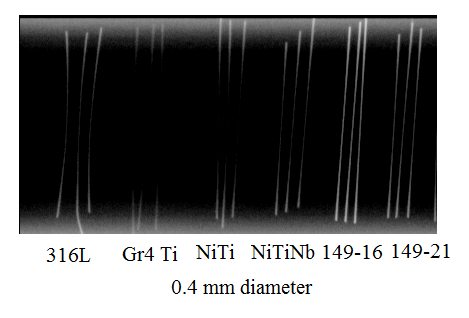R&D
- Aug 1, 2018
Aging and Shapeset Performance of a Radiopaque Super-Elastic Beta Titanium Alloy for Vascular and Orthopedic Applications
S. Cai, PhD, R&D Engineer
J.E. Schaffer, PhD, Director of R&D
Beta titanium alloys can be used in place of Nitinol as a nickel-free alternative in certain medical device allergy-sensitive applications, particularly in wear environments where particles of base metal can permeate tissue [1]. Fort Wayne Metals began this work to provide improved care in such devices where Nitinol’s superelastic properties are desired but the chemistry is contraindicated.
The work began as an improvement to alloys developed in the 1970s by Baker, et al. [2]. After trials in other beta titanium systems [3, 4], the Fort Wayne Metals Research and Development team has recently produced beta titanium alloys with large and stable superelasticity (4% recoverable tensile strain), improved radiopacity and good apparent ISO 10993 “bio-friendliness” (publications forthcoming). These alloys, one high Hf variant (code “149-16”, Figure 1) discussed here for vascular implantables, and one lower cost, high Zr version (“149-21”, Figure 1) for orthopedics, are showing promise in medical devices to treat vascular diseases such as for Ni-free aneurysm flow diverters, and elastic bone fixation devices, respectively. A key advantage is that, where wear may occur in a braided scaffold or at the bone interface, no nickel is present to provoke an immune response and yet, the material delivers “Nitinol-like” elasticity.
A cold drawn sample of either alloy, after stress-relief or shape set processing, can fully recover almost 4% deformation strain (Figure 2) due to the reversible stress-induced martensite phase transformation. Its plateau stress can be further tuned by aging at low temperatures. Figures 2 and 3 contain yield strength and modulus data showing a positive correlation with increasing dwell time and rather constant ultimate tensile strength and fatigue cycles at a particular rotating-beam test (RBT) condition (1% alternating strain, 37°C, RO water, R = -1). This reaction, useful in tuning properties to specific device demands, is more pronounced at the early stage of aging. It is worth noting that the fatigue performance of this alloy is similar to straight annealed NiTi (e.g. 50.8% Ni, Af 10-18°C, light oxide surface) under the same RBT test conditions.
If you have questions, or want to know more about other projects and innovations, we'd like to hear from you. Please contact us: [email protected]

Figure 1: Radiopacity of different alloys.

Figure 2: Stress-strain curves after different heat treatment. Sample diameter is 0.32mm.

Figure 3: Influence of aging time on a) mechanical properties and b) fatigue cycles at 1% strain. Fatigue was done on a rotary beam fatigue tester in a 37°C RO water. Wire sample diameter is 0.32mm.
References
[1] Lukina, Elena, et al. "Fretting corrosion behavior of nitinol spinal rods in conjunction with titanium pedicle screws." Materials Science and Engineering: C 72 (2017): 601-610.
[2] Baker, C. "The shape-memory effect in a titanium-35 wt.-% niobium alloy." Metal Science Journal 5.1 (1971): 92-100.
[3] Cai, Song, Jeremy E. Schaffer, and Yang Ren. "Stress-induced phase transformation in a Ti–17Nb–1Cr alloy." Materials Research Letters 4.3 (2016): 161-167.
[4] Cai, S., J. E. Schaffer, and Y. Ren. "Stress-induced phase transformation and room temperature aging in Ti-Nb-Fe alloys." Materials Science and Engineering: A 680 (2017): 13-20.
Disclaimer: Our updates are sneak peeks of what our R&D department is working on. This is not meant to imply that we have what is referenced above ready for robust serial manufacture.